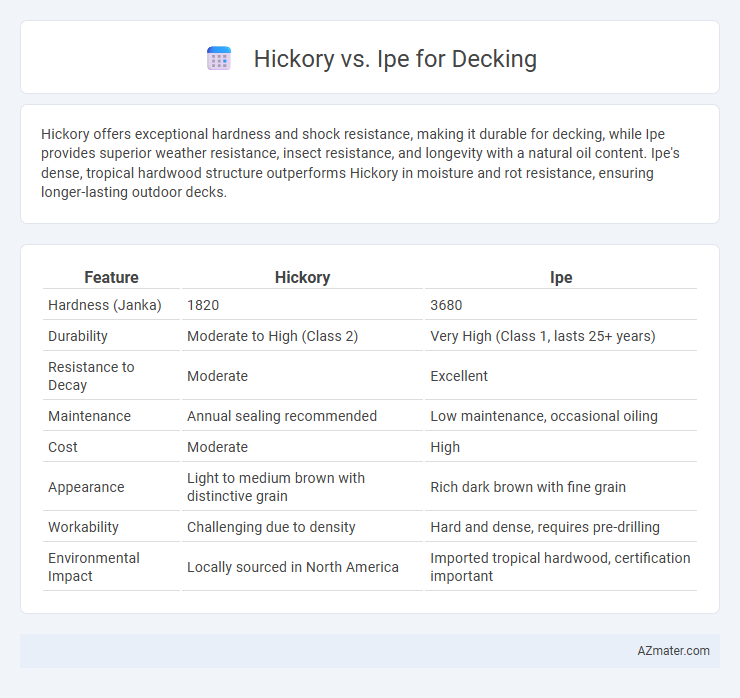Hickory offers exceptional hardness and shock resistance, making it durable for decking, while Ipe provides superior weather resistance, insect resistance, and longevity with a natural oil content. Ipe's dense, tropical hardwood structure outperforms Hickory in moisture and rot resistance, ensuring longer-lasting outdoor decks.
Table of Comparison
| Feature | Hickory | Ipe |
|---|---|---|
| Hardness (Janka) | 1820 | 3680 |
| Durability | Moderate to High (Class 2) | Very High (Class 1, lasts 25+ years) |
| Resistance to Decay | Moderate | Excellent |
| Maintenance | Annual sealing recommended | Low maintenance, occasional oiling |
| Cost | Moderate | High |
| Appearance | Light to medium brown with distinctive grain | Rich dark brown with fine grain |
| Workability | Challenging due to density | Hard and dense, requires pre-drilling |
| Environmental Impact | Locally sourced in North America | Imported tropical hardwood, certification important |
Introduction to Hickory and Ipe Decking
Hickory decking offers a durable and visually appealing hardwood option known for its excellent shock resistance and distinctive grain patterns, making it suitable for outdoor flooring. Ipe, a tropical hardwood from South America, is highly prized for its exceptional density, natural resistance to decay, and rich dark brown color that enhances decking longevity. Both hardwoods provide significant strength and weather resistance, with Ipe often preferred for its superior durability and low maintenance requirements in harsh climates.
Origin and Availability of Hickory and Ipe
Hickory wood, primarily sourced from the eastern United States, is valued for its strength and shock resistance, making it a durable option for decking. Ipe, harvested predominantly from the rainforests of Central and South America, is renowned for its exceptional hardness and natural resistance to decay and insects. While hickory's availability can fluctuate due to regional growth cycles and harvesting regulations, ipe is widely available through sustainable forestry programs, though it often comes with a higher cost due to importation and durability.
Appearance and Aesthetic Differences
Hickory decking offers a warm, rustic appearance with a natural golden-brown hue that darkens over time, featuring prominent grain patterns and occasional knots for a textured, organic look. Ipe, known for its rich, deep reddish-brown color and fine, smooth grain, provides a sleek, uniform aesthetic that ages gracefully to a silver-gray patina if left untreated. The contrasting visual qualities make Hickory ideal for traditional, natural settings, while Ipe suits modern designs seeking a polished, high-end finish.
Durability and Lifespan Comparison
Ipe wood boasts exceptional durability with a natural resistance to rot, insects, and weather, often lasting over 50 years with minimal maintenance, making it one of the most long-lasting decking materials available. Hickory, while tough and hard, is less resistant to moisture and insect damage, resulting in a shorter lifespan typically around 15 to 20 years when used outdoors without extensive treatment. The superior density and natural oils in Ipe contribute to its significantly greater lifespan and durability compared to Hickory in decking applications.
Weather and Pest Resistance
Ipe decking offers superior weather resistance, with natural oils and dense grain that withstand extreme moisture, sunlight, and temperature changes without warping or splintering. Hickory, while strong, is less resistant to moisture and prone to insect damage, requiring regular sealing and maintenance to prevent rot and pest infestations. Ipe's exceptional durability against termites and decay makes it a top choice for long-lasting, low-maintenance outdoor decking.
Maintenance Requirements
Hickory decking requires frequent sealing and periodic refinishing to protect against moisture and insect damage, making maintenance more intensive compared to Ipe. Ipe offers exceptional natural durability and resistance to rot and decay, often needing only annual cleaning and occasional oiling to maintain its rich color. Both hardwoods benefit from proper installation and drainage to extend their lifespan and preserve structural integrity.
Cost and Value Analysis
Hickory decking generally costs between $5 to $7 per square foot, offering a strong, durable hardwood option with moderate maintenance needs, while Ipe ranges from $8 to $14 per square foot, known for its exceptional density and resistance to rot and insects. Although Ipe requires a higher initial investment, its longevity of up to 40 years and minimal upkeep can provide better long-term value compared to Hickory's lifespan of around 15 to 20 years. Considering both materials, Ipe's premium price is balanced by superior durability and reduced maintenance expenses, making it a cost-effective choice for high-end decking projects.
Installation Considerations
Hickory decking requires careful sealing and moisture control during installation to prevent warping due to its high density and moisture absorption. Ipe, known for its exceptional hardness and natural resistance to rot and insects, demands pre-drilling pilot holes and stainless steel fasteners to avoid splitting and ensure longevity. Proper acclimatization and the use of corrosion-resistant hardware are critical for both, with Ipe offering superior durability but more challenging installation compared to Hickory.
Environmental Impact and Sustainability
Hickory decking is sourced from fast-growing hardwood trees, making it a more sustainable option due to shorter harvest cycles and potential for responsible forest management. Ipe, known for its density and durability, comes from slow-growing tropical rainforest trees, often raising concerns about deforestation and habitat loss without proper certification like FSC. Opting for FSC-certified Ipe ensures reduced environmental impact by promoting sustainable harvesting practices and preserving biodiversity.
Which is Better for Your Deck: Hickory or Ipe?
Ipe offers superior durability and natural resistance to rot, insects, and weather, making it one of the best hardwoods for decking with a lifespan of 25-50 years. Hickory provides a unique, rustic aesthetic with high density and strength, but requires regular maintenance and sealing due to its susceptibility to moisture and insects. For long-term value and minimal upkeep, Ipe is generally the better choice when comparing hardwood decking options.

Infographic: Hickory vs Ipe for Decking
 azmater.com
azmater.com